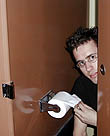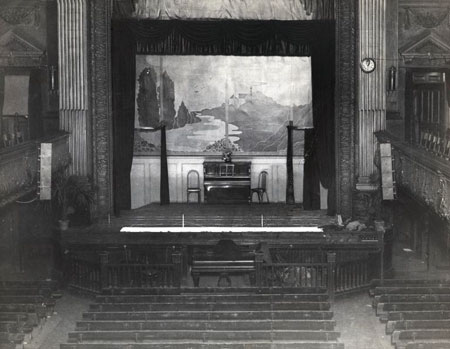|
|
This topic comprises 3 pages: 1 2 3
|
|
Author
|
Topic: Glen Cinema Disaster of 1929
|
Nate Lehrke
Master Film Handler

Posts: 396
From: Denver, CO
Registered: Oct 2002
|
 posted 01-26-2005 01:51 AM
posted 01-26-2005 01:51 AM




I have never heard of this story and thought it was kind of “interesting”. Not many of us will be able to watch the documentary but if by chance we do have some members in Scotland, they might want to view it.
quote: SOURCE
NEW documentary is set to reveal the nightmare suffered by survivors of the Glen Cinema disaster.
The tragedy, which took place on Hogmanay in 1929, saw 71 children from Paisley die in the worst movie theatre accident in Scotland.
Now BBC Scotland's Ex: S documentary The Glen Cinema Disaster traces the events that saw 900 youngsters packed into the tiny picture house to watch a cowboy film.
After the front door was closed to prevent more kids crowding in, fire broke out. The youngsters who survived, on average five years old at the time, were forbidden to talk about the tragedy. As a result, without therapy or the chance to share their grief, they have never found closure. The pain of seeing little friends die has never gone away. Sadie Elias recalled: "The place was mobbed with children. Some were 12-year-olds with babies in their arms, little brothers or sisters. And they died. It's always been in my mind. And it always will be."
Peter Smith, who was also around five at the time, recalls instructions given to survivors. "We were told to keep our mouths shut afterwards. There were no psychoanalysts in those days, no-one to help you come to terms with what you'd seen. "The only 'treatment' I got was being sent by the Co-operatitve to a Children's Home in West Kilbride for a week. "But every night when I came back I would wake up shouting and screaming, 'Fire! Fire! Help!'"
Months after the victims were laid to rest in a mass grave, new regulations were brought in that would make sure such a disaster could never take place again.
The cinema now houses a furniture shop.
• The Glen Cinema Disaster, BBC1 Scotland, February 1, 10.30pm.
The Glen Cinema Documentary made by Corruption Films for BBC Scotland will be screened on Tuesday 1st of February on BBC One Scotland at 10.30pm. It includes footage never seen before of the interior of the cinema and also shots about the latest commemorative project inititaed by The Paisley Development Trust. Don't miss it!
Photo's from the disaster
| IP: Logged
|
|
|
|
|
|
|
|
Leo Enticknap
Film God

Posts: 7474
From: Loma Linda, CA
Registered: Jul 2000
|
 posted 01-26-2005 03:31 PM
posted 01-26-2005 03:31 PM





First off, here's a quote from Roger Smither's 'Calendar of Film Fires' in his definitive, 690-page book on the history of nitrate:
quote: Smither & Surowiec, 'This Film is Dangerous', p. 441
31 December [1929] - Glen Cinema, Paisley, Scotland, UK
Working in a rewind room during a matinee attended by some 700 children, an assistant placed a can of film on top of a wet-cell battery, causing a short circuit between the terminals. This was the apparent cause of a fire which, in itself, was not particularly serious: but the assistant then left the burning can in a passage while he went to look for a manager to unlock an exterior door so that he could throw the can outside. During this delay smoke and panic spread through the auditorium, and the audience rushed to escape. One of the emergency exits was obstructed, and 70 children died [Leo's note: I've read various accounts putting the death toll at 69, 70 and 71 - I don't know which is correct] while some 30 to 40 more were injured in the resulting crush. Eighteen years after the tragedy the author of a popular work on British cinema could still note, "Quite recently I heard a careless visitor to a cutting room who had a cigarette between his lips adjured with 'Would you mind dropping that and putting your foot on it, sir - remember Paisley!.'" Reference: Major T.H. Crozier, H.M. Chief Inspector of Explosives, Report to the Right Honourable Secretary of State for Scotland on the Circumstances attending the Loss of Life at the Glen Cinema, Paisley, on the 31st December 1929 (London, HMSO, 1930).
My guess would be that the kid(s) were told to shut up because their parents knew or had some connection to the assistant who left the burning reel in the corridor. Can't think of any other reason. A Scottish relative has offered to video the programme for me, so all may be revealed next week, I guess.
| IP: Logged
|
|
William Hooper
Phenomenal Film Handler
Posts: 1879
From: Mobile, AL USA
Registered: Jun 99
|
 posted 01-27-2005 05:09 AM
posted 01-27-2005 05:09 AM





Most of the Iroquois disaster was the result of violations of existing fire & construction codes. Fire doors were chained shut, equipment not tested, no signs at exits, failure to observe material & construction standards in things like THE FIRE CURTAIN, for Pete's sake.
Folks were instantly incinerated on the main floor because the fire curtain track construction did not adhere to code, & was constructed of wood. The fire started onstage (& that was a more common, non-deadly occurrence than you'd expect in the days of gas lighting). When the fire curtain was dropped, it jammed in the track a few feet from the stage floor, the heat & fire superheated in the stage house & fly tower, & a huge fireball erupted from beneath the fire curtain & blowtorched the auditorium.
| IP: Logged
|
|
Stephen Furley
Film God

Posts: 3059
From: Coulsdon, Croydon, England
Registered: May 2002
|
 posted 01-27-2005 10:51 AM
posted 01-27-2005 10:51 AM




A number of questions arise here.
quote:
Working in a rewind room during a matinee attended by some 700 children, an assistant placed a can of film on top of a wet-cell battery, causing a short circuit between the terminals. This was the apparent cause of a fire which, in itself, was not particularly serious:
Wet batteries can supply a lot of current. I wouldn't be surprised if that caused an arc which burned through a metal can, and ignited the film. What was a battery doing in the rewind room? In any nitrate era installation I've seen in this country the battery room was kept well away from the rewind room. If the can could be put on top of it, it sounds as if the battery was not installed in any way, but had just been taken into the rewind room for some reason, maybe to power a lamp, or something. I don't know the regulations in Scotland at the time, but I seriously doubt that this complied with them.
quote:
The assistant then left the burning can in a passage while he went to look for a manager to unlock an exterior door so that he could throw the can outside.
Basil Fawlty cinemas? Bad training of staff, possibly. Did the assistant not know what to do in the event of a film fire? If his job involved handling film then he should have done. I wonder where this passage was? An exterior door from it surely shouldn't have been locked while the building was in use. How are the projectionists supposed to escape from the fire?
quote:
During this delay smoke and panic spread through the auditorium, and the audience rushed to escape. One of the emergency exits was obstructed, and 70 children died
Returning to the passage, How did the smoke get into the auditorium? The burning film was in a passage. A passage leading from the projection and rewind rooms should have led out of the building surely. Sounds like unsuitable design and/or construction of the building for the purpose. How did it manage to get a cinematograph licence?
Do we know how they died? Was it from smoke inhalation, or simply the crush in trying to get out of the building? The emergency exit shouldn't have been obstructed, of course, but even if it hadn't been, an auditorium filling with smoke, and an audience in panic is not good.
If this had happened 25 years earlier, maybe I could understand it, but by 1929 a small film fire in a rewind room really shouldn't have put the audience in any danger.
Leo, if any of these questions are answered in the programme I'd be interested to hear about it.
I've been in two American projection rooms, both from the nitrate era, and even without later changes which have been made, the design of both of them would not have met the regulations in Britain at the time. On the other hand, American rewinders always seem to have been enclosed, which British ones were not. Obviously these (enclosed ones) could not be used for inspecting film. How was film inspected in American cinemas at that time?
By the '30s, we seem to have wanted to create more separate rooms for technical facilities than was usual in other countries. Rooms I've seen include:
Fan room
Rectifier/Generator room
Auxilliary rectifier room
Battery room
Dimmer room
Amplifier room
Non-sync room
Slide room
Spot box
Projection room
Rewind room
Inspection room
Workshop
Water cooler room
Film vault
General store
Carbon store
Can't remember the name of the system, but room containing motor driven shafts with cams operating multi-coloured auditorium lighting.
This is in addition to various non-technical rooms, Chief's office, toilet etc.
It's difficult to see why the slide lantern should need its own room, in most places it didn't, unless it was a union requirement to justify the need for an extra operator.
| IP: Logged
|
|
Hugh McCullough
Expert Film Handler

Posts: 147
From: Old Coulsdon, Surrey, UK
Registered: Jan 2003
|
 posted 01-27-2005 11:37 AM
posted 01-27-2005 11:37 AM





Stephen Furley said
quote: Stephen Furley
Can't remember the name of the system, but room containing motor driven shafts with cams operating multi-coloured auditorium lighting.
I have worked in cinemas with this system, and it was always called the Motorised Trailer Dimmer Room.
Never knew why it should have such a long name, but I imagine it was because the carbon wipers were trailed (pulled) across the brass contacts of a wire wound resistance system by a motor, and not by hand.
quote: Stephen Furley
How did the smoke get into the auditorium?
Maybe the passage, as well as leading to the outside, also led to the auditorium, and the auditorium door was wedged open for ventilation purposes. Quite criminal.
I always understood that not only was the exit door obstructed with rubbish, but also opened inwards therefor the children trying to pull it open were stopped by the crush of children behind. After this all exit doors had to open outwards.
| IP: Logged
|
|
|
|
|
|
Stephen Furley
Film God

Posts: 3059
From: Coulsdon, Croydon, England
Registered: May 2002
|
 posted 01-28-2005 06:44 AM
posted 01-28-2005 06:44 AM




I'm a bit puzzled here.
quote: Leo Enticknap
I guess the 1909 Cinematograph Act applied throughout the UK, though Scotland may have had separate legislation. If the 1909 Act was in force then you're right - this place was breaking several bits of it.
quote:
Months after the victims were laid to rest in a mass grave, new regulations were brought in that would make sure such a disaster could never take place again.
I would have thought that the 1909 act would have applied, but if it did, and if it had been complied with, it would almost certainly have prevented this disaster. It covered emergency exits, staffing, isolation of film handling areas from the auditorium, and electrical equipment in film handling areas, all the things which seem to have been at fault here. If the 1909 act applied then I don't see the need for 'new regulations'; the existing ones just needed to be complied with. Maybe somebody just needed to be seen to be doing something.
I think the only electrical equipment allowed in rewind rooms was fixed lighting, and that had to be enclosed, flameproof fittings, with all cables enclosed in metal conduit. That would have ruled out the battery to start with.
Was this place built as a cinema, or was it converted from an older building? The 1909 act resulted in many new, purpose-built cinemas opening in Britain in 1910, due to the cost and difficulty of bringing many of the buildings previously used, often conversions of existing halls, shops etc. up to the new standards. A number of these 1910 cinemas are still in use; they tend to have had their capacity reduced over the years, often to only one third to one half of what it was originally. Looking at the numbers quoted at the time of opening, they seemed to really 'cram them in' in those days.
Between about 1928 and 1938 the big 'Super Cinemas wer built in Britain; the War pretty much put a stop to such things in 1939. Presumably the Glen was either an old converted bulding, or one of the early purpose-built cinemas. In 1929 could it have been facing competion from one of more nearby 'Super Cinemas', and things have been going downhill, with no money available for improvements?
quote: Hugh McCullough
I always understood that not only was the exit door obstructed with rubbish, but also opened inwards therefor the children trying to pull it open were stopped by the crush of children behind. After this all exit doors had to open outwards.
I'd heard of this accident, but knew nothing of the details. Simple common sense would seem to suggest that emergency exits from buildings containing large numbers of people should open outwards. Such buildings, Theatres, concert halls etc. existed long before film of course. It seems incredible that emergency exits would still have been opening inwards in 1929.
quote: Leo Enticknap
Again, this relates to Joe's question as to why the kids were told to shut up: this could have been for fear of criminal negligence accusations flying about, and not just aimed at this one operator.
If the facts were as has been described here, then the cinema would seem to have been badly managed and badly operated. Both the chief projectionist and the manager could well have been critisised.
Edit, after seeing the pictures posted by Mark.
Looking at the auditorium picture, this is clearly an old building, not originally designed as a cinema. The small, rather high stage, and balcony on three sides, suggests that it might have been a music hall at some time. No indication as to the construction of the projection facilities, which were obviously added later, but the fact that smoke was able to get into the auditorium suggests that they were inadequate.
[ 01-28-2005, 08:00 AM: Message edited by: Stephen Furley ]
| IP: Logged
|
|
|
|
|
|
William Hooper
Phenomenal Film Handler
Posts: 1879
From: Mobile, AL USA
Registered: Jun 99
|
 posted 01-31-2005 03:30 AM
posted 01-31-2005 03:30 AM





I agree with Stephen Furley: that looks like an older, existing building adapted for use as a cinema. You might check with someone perhaps at the Cinema Theatre Association to see if they've got more info.
The construction of the galleries which extend along the side walls was pretty much over even in live theatres in US by the very end of the 1800's. I'll bet everything in front of the new projection booth construction met existing fire codes at the time of construction. The fire proceeding from the booth & other new construction is probably what became the problem.
Is that first picture from before its adaptation to use as a cinema? They've got a piano in the pit, & another onstage! Or are the piano & chairs painted on the drop? From the angle of view, it should be that we're looking down onto the chair seats, & yet they present almost 100% profile! What are those things in the box boom positions? FOH lights? Speakers?
quote: Leo Enticknap
Again, this relates to Joe's question as to why the kids were told to shut up: this could have been for fear of criminal negligence accusations flying about, and not just aimed at this one operator.
There's also the contemporary "We don't talk about horrible, emotionally-scarring catastrophes" cultural tenet of the time which reached its finest flower in the southeast United States in the end of the 1800's, where the late Civil War was referred to as "the recent unpleasantness".
quote: Stephen Furley
I've been in two American projection rooms, both from the nitrate era, and even without later changes which have been made, the design of both of them would not have met the regulations in Britain at the time. On the other hand, American rewinders always seem to have been enclosed, which British ones were not. Obviously these (enclosed ones) could not be used for inspecting film. How was film inspected in American cinemas at that time?
By hand rewinds on a bench, as far as I know. Motorized rewinds are just for rewinding a reel that's already been run & has no problems.
quote:
By the '30s, we seem to have wanted to create more separate rooms for technical facilities than was usual in other countries. Rooms I've seen include: [...] Can't remember the name of the system, but room containing motor driven shafts with cams operating multi-coloured auditorium lighting.
The things you've seen & are probably thinking of were the rooms which contained the contactors & cam-driven programming for the big vertical signs & marquees which had bazillions of programmed, animated incandescent bulbs. Generally, they're located in a room very near the back of the booth, since that location is also very near the outside wall where the signs are located.
I've never seen 3-color auditorium lighting driven by programmed cam-driven automation. It's usually manually set for whatever look you like, then there may be an auxilliary dimmer to dim all the circuits down at the top of the show, not requiring any alteration of the independent settings of the 3- (or 4-) color circuits. The dimmer just is an additional resistor smack across all the different circuits. Sometimes (& more often later), it is motorized. Its placement varies with theatre design: sometimes it's near the booth, sometimes the aux dimmer is motorized & only control voltage goes from the booth to wherever the aux dimmer is located (sometimes even in the air plenum under the auditorium, more or less directly under the booth!)
quote: Stephen Furley
How did the smoke get into the auditorium?
Assuming that the booth was new construction added at some unknown date, & not knowing the design of the new construction or existing building, it's not easy to guess. If it was just a room made of partition walls at the back of the house, smoke could have made an exit through incomplete construction. If that room was not fireproof & communicatied with the attic, it could have gone that way; if the booth adjoined or was constructed in the passage used for access by the audience at the back of the upper gallery, it could have done as Hugh McCullough suggests, etc.
quote: Bernard Tonks
Ironically “The Crowd” 1928 is being screened in the UK on TCM Wednesday 2nd February at 13.00 hours. Directed by King Vidor, BBFC ‘U’ certificate. Must have been quite an epic in its time
"The Crowd" was quite a prestige picture, & remains a VERY good movie today. An excellent example of the maturity of film in the late silent era. I think Scott Norwood mentioned that he saw it somewhere & liked it a lot.
| IP: Logged
|
|
|
|
|
|
All times are Central (GMT -6:00)
|
This topic comprises 3 pages: 1 2 3
|
Powered by Infopop Corporation
UBB.classicTM
6.3.1.2
The Film-Tech Forums are designed for various members related to the cinema industry to express their opinions, viewpoints and testimonials on various products, services and events based upon speculation, personal knowledge and factual information through use, therefore all views represented here allow no liability upon the publishers of this web site and the owners of said views assume no liability for any ill will resulting from these postings. The posts made here are for educational as well as entertainment purposes and as such anyone viewing this portion of the website must accept these views as statements of the author of that opinion
and agrees to release the authors from any and all liability.
|

 Home
Home
 Products
Products
 Store
Store
 Forum
Forum
 Warehouse
Warehouse
 Contact Us
Contact Us




 Printer-friendly view of this topic
Printer-friendly view of this topic

















